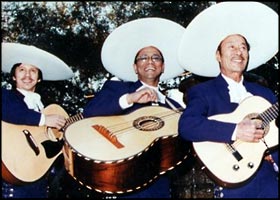Mariachi
"The Sound that Speaks to Your Emotions"4
In the Beginning
Mariachi music dates as far back as the beginning of the nineteenth century. During the beginning of the Spanish conquest, music was used as a form of communication and the spreading of their Christian religion. Throughout this period of time Spanish theater was also a strong part of the popular culture.
Originally the music of Mexico included drums, rattles, flutes, and shell horns Over time the people of Mexico altered the Spanish theatrical orchestra and made it their own. This new type of orchestra was made up of violins, trumpets, and a guitar. Today, the mariachi band has six to eight violins, two trumpets, a guitar, and instruments traditional to Mexico. The viheula, a round back guitar, is strummed to keep the rhythm of the mariachi music, the guitarron is similar to a bass guitar and there is also a folk harp.3 The music is also accompanied by gritos, shouts or cries that express their happiness in celebration.
Mariachi music can be used as a way of communicating. The mariachi music can be used as a way of serenading another person of the opposite sex. When the two lovers were separated they could send each other a musical message on their behalf thanks to the mariachis.5
Mariachi music like much of the music of the Latino cultures, is a music of the people. Mariachi music was of the lower class commoners but it was not just a song but a dance as well, something that was taught only by ear. The mariachi music is of the country people, it celebrates their struggles, joys and growth of the people. Mariachi music is often present at important events and celebrations in the lives of the Latino people. It is common to listen to the mariachis at baptisms, weddings, on holidays, and even at funerals.
What's in a name?
There have been several different theories explaining the birth of the word “mariachi”. It is difficult to prove which of the many theories are true, however some have been disproved after further discoveries.
For example, one of the most common and prevalent theories is that the word “mariachi” comes from the French word “mariage” for marriage. It was said that marriages were the most common use of mariachi band during the mid-nineteenth century, throughout 1862-1866, when the French occupied parts of Mexico. This theory was later disproved when a letter from a Catholic priest, Cosme Santa Anna was discovered; the letter referred to the bands and even used the word “mariachi” to describe them. The letter was said to be dated in the year 1852, nearly a decade before the presence of the French in Mexico.3
 |
|---|
There were also two other possible theories. One theory discussed the importance of religion in the Mexican culture and believe that “mariachi” may have been derived from the important name of the Virgin Mary or Maria and -chi was a common part of an earlier native language. This same native language is the basis of the second theory. This theory, more common, states that the word comes from a native, Cora Indian word. The word ‘ma’ria’chi’ refers to a specific tree. The wood from this tree may have been commonly used to construct the first instruments for the mariachis or to build the platform that the dancers or bands often performed on. 3
A Way of Life
In the early twentieth century, 1936 President Lazaro Cardenas was campaigning for office. President Cardenas believed that in order to unify the separate regions of Mexico he would have Mariachi Vargas de Tecalittlan accompany him on his campaign, music was the unifying element. This event contributed greatly to the popularity of the mariachi music.4
Today Mariach music is present in festivals, concerts, and now even schools throughout the world. Mariachi music is more common in several school systems in states such as Texas, Arizona, California and New Mexico. The music is fun to play and many of the students are able to learn abour something, the mariachi music, that is a large part of their cultural past, present, and future.